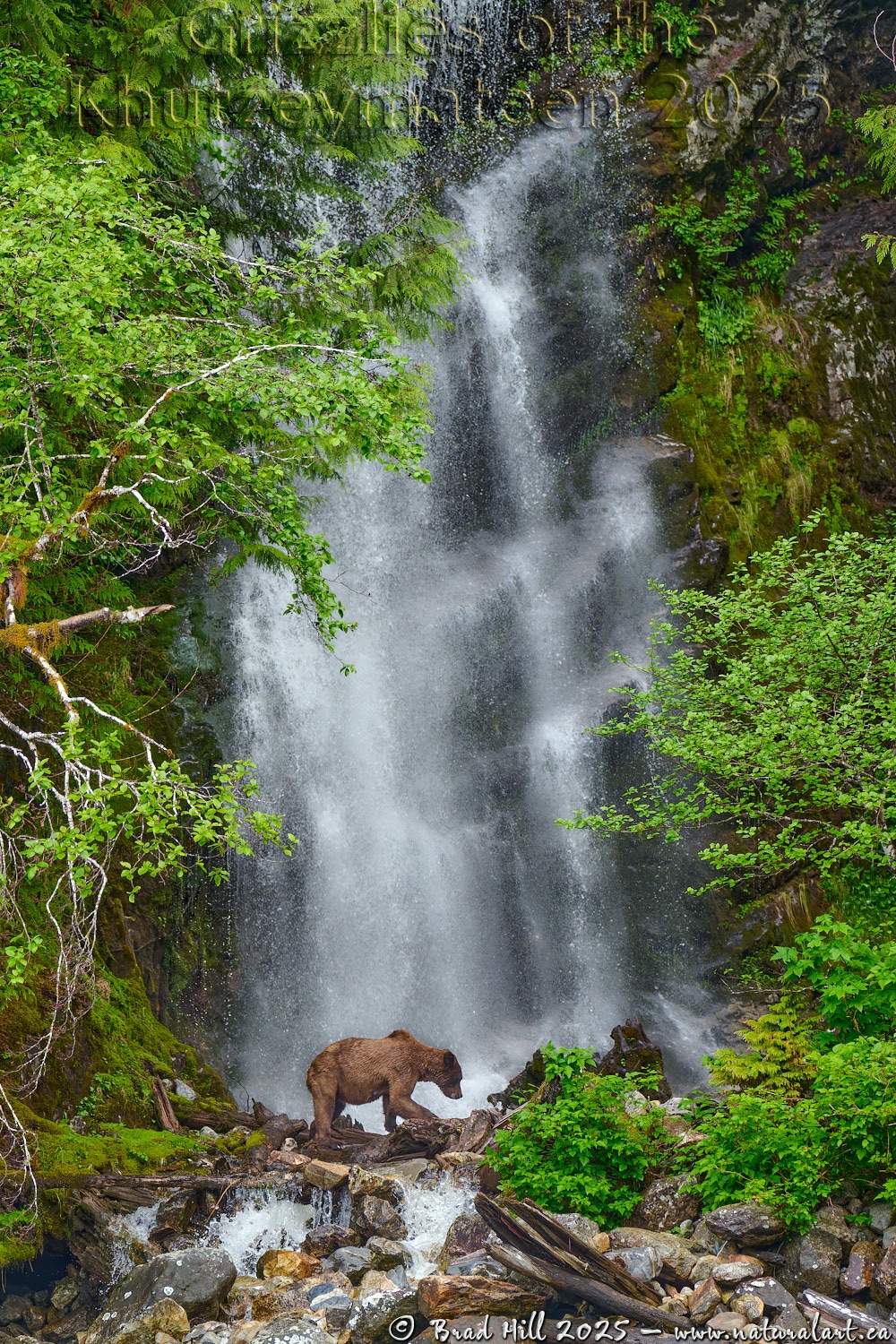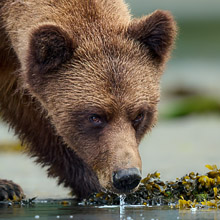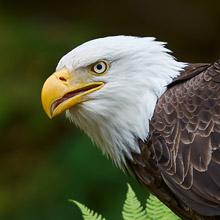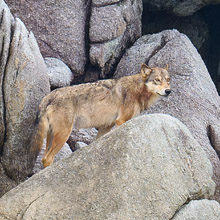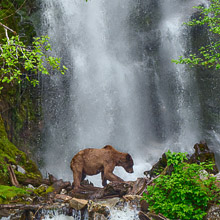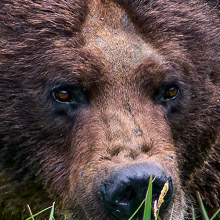Availability: Undetermined - Enquiries?
In the Field
The Crossing. Khutzeymateen Inlet, British Columbia, Canada. June 1, 2025.
I captured this image of a female Grizzly Bear crossing in front of a picturesque coastal waterfall during my 2025 Grizzlies of the Khutzeymateen Photo Op photo tour. Even though I have been traveling to the Khutzeymateen Grizzly Sanctuary to photograph its famous grizzlies since 2006 there are still several shots/scenes there that I have long wanted to capture (but have so far eluded me!). This is one of those shots. Until this year I have never seen a grizzly near these falls. And, almost bizarrely coincidentally, the very day this shot was captured I was chatting with our guide about how he had finally seen a grizzly cross in front of the falls just a year ago (and that I had NEVER seen it). Then, just a few hours later, we saw a bear approaching the falls! We quickly positioned our Zodiac in the hopes the bear would continue on and pass in front of the falls. And our luck held - and we witnessed (and photographed) this wonderful scene.
Not too long before this image was captured I acquired a copy of the Tamron Z 35-150mm f2-2.8S. As is my normal practice I tested the lens very thoroughly before adding to my kit. The lens tested out very well - it's sharp over its entire focal range, including when shot wide open. While larger and heavier than its closer competitor in the Nikon lineup (which I consider to be the excellent Z 24-120mm f4S) its faster aperture and corresponding ability to better separate out the subject from its background appealed to me. I took this lens with me on this trip into the Khutzeymateen and it performed very, very well. This image was captured with the Tamron Z 35-150mm.
Those who look at the tech specs of this shot may question why I chose to shoot the image at f2.5 (rather than stopping down more to wide its depth of field). We had only a minute or so to set up for this shot, and I thought that if the bear passed in front of the falls on the top edge of the rocks then everything that was critical in the foreground and the surrounding trees would be in sharp focus at f2.5 - but the streaming water of the falls would be far enough behind the subject to be slightly soft (which is exactly what I wanted). Of course, shooting at a slower shutter speed to soften the streaming water wasn't an option (unless I wanted the bear to be a blurry mess!). Fortunately, my quick assessment proved to be accurate. Phew! 😉.
Here's a larger version (4800 pixel) of this grizzly animalscape:
• The Crossing: Download 4800 pixel image (JPEG: 11.3 MB)
ADDITIONAL NOTES:
1. These images - in all resolutions - are protected by copyright. I'm fine with personal uses of them (including use as desktop backgrounds or screensavers on your own computer), but unauthorized commercial use of the image is prohibited by law. Thanks in advance for respecting my copyright!
2. Like all photographs on this website, these images were captured following the strict ethical guidelines described in The Wildlife FIRST! Principles of Photographer Conduct. As such, no baiting or any form of attractant was used and, as always, we attempted to minimize our impact on the ongoing behaviour of the subjects. I strongly encourage all wildlife photographers to always put the welfare of their subjects above the value of their photographs.
3. This image was captured during my Grizzlies of the Khutzeymateen Photo Op photo tour in late spring of 2025. Each year I offer trips into the Great Bear Rainforest as well as tours into the Khutzeymateen Grizzly Sanctuary (to photograph grizzlies, of course!). Details about these trips can be found on the Photo Tours page of this website.
Behind the Camera
The Crossing. Khutzeymateen Inlet, British Columbia, Canada. June 1, 2025.
High Efficiency* Compressed RAW (NEF) format; ISO 560.
Nikon Z 9 paired with Tamron Z 35-150mm f2-2.8 @ 79mm. Hand-held from a floating Zodiac inflatable boat. VR on in Sport mode. 3D-tracking AF area mode with subject detection on "Birds" mode.
1/640s @ f2.5; -0.33 stop compensation from matrix-metered exposure setting.
At the Computer
The Crossing. Khutzeymateen Inlet, British Columbia, Canada. June 1, 2025.
Initial noise reduction and capture sharpening on the .nef (raw) file using the DeepPRIME XD2S algorithm of DXO PhotoLab 8.7 Elite (using the appropriate lens/camera optical module).
Subsequent adjustments to the adjusted linear DNG file (exported from PhotoLab) and conversion to 16-bit TIFF file (and JPEG files for web use) - including all global and selective adjustments - made using Capture One Pro (build 16.6.3). In the case of this image the only global adjustments were minor tweaks to contrast (a Levels adjustment) and both the blacks and the highlights. Selective local adjustments performed using Capture One Pro's layers and masking tools. In this case numerous small adjustments and minor tweaks were made on 7 separate layers, with the tweaks being associated with "exposure balancing" and contrast adjustments (such as adjustments to brightness, clarity, highlights, shadows, etc.).
Photoshop modifications included insertion of the watermark and/or text.
Conservation
The Crossing. Khutzeymateen Inlet, British Columbia, Canada. June 1, 2025.
Species Status in Canada*: Special Concern (May 2002).
While Grizzly Bears (Ursus arctos) are not technically listed as "Endangered" in Canada, they have been extirpated from most of their historical range. Grizzly Bears are far more sensitive to intrusion/disturbance in their habitat than are Black Bears and are being increasingly forced into marginal habitat by human encroachment. The Great Bear Rainforest along the central and northern coast of British Columbia is one of the last strongholds of the Grizzly Bear in Canada, and even this population is coming under increasing pressure.
On December 18, 2017 the government of British Columbia banned grizzly hunting across the entire province. This major conservation victory came after decades of tireless work by many dedicated conservationists and ecologists and, most importantly, it reflects the opinion of the vast majority of British Columbians. And, it means that AT LEAST while the current government remains in power grizzlies are finally "safe" in British Columbia.
Now that we've at least temporarily won the battle to save grizzlies in BC, it's time to re-focus our efforts toward protecting ALL of BC's carnivores, including Gray Wolves, Black Bears, Cougars, Wolverines, and more! Simply put, there are no ecological, economic, or ethical arguments supporting the trophy hunting of carnivores.
*as determined by COSEWIC: The Committee on the Status of Endangered Wildlife in Canada













